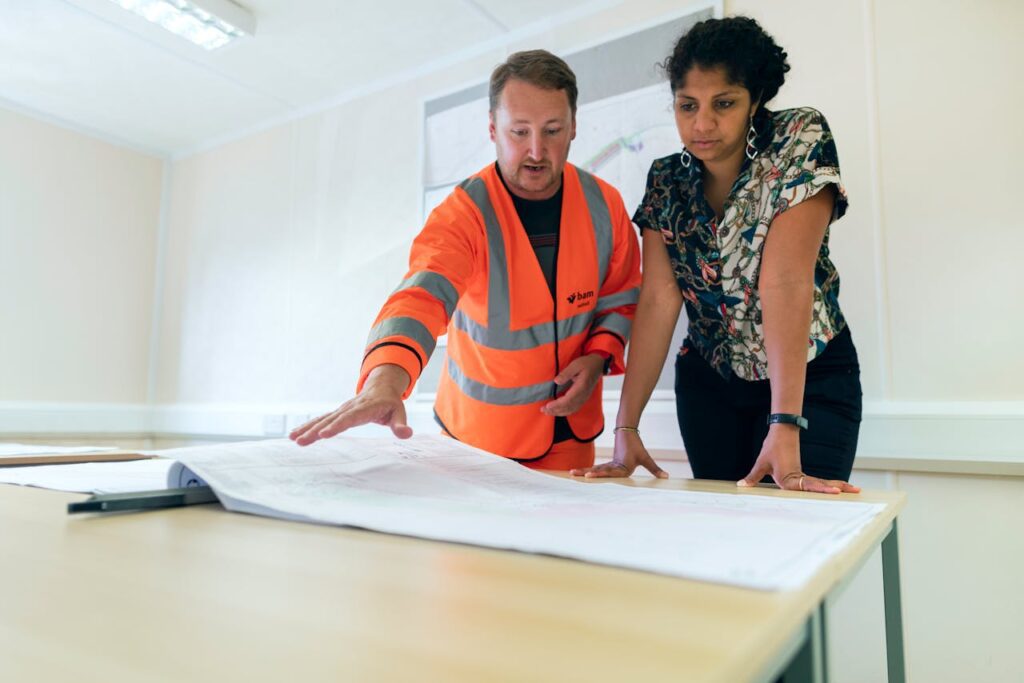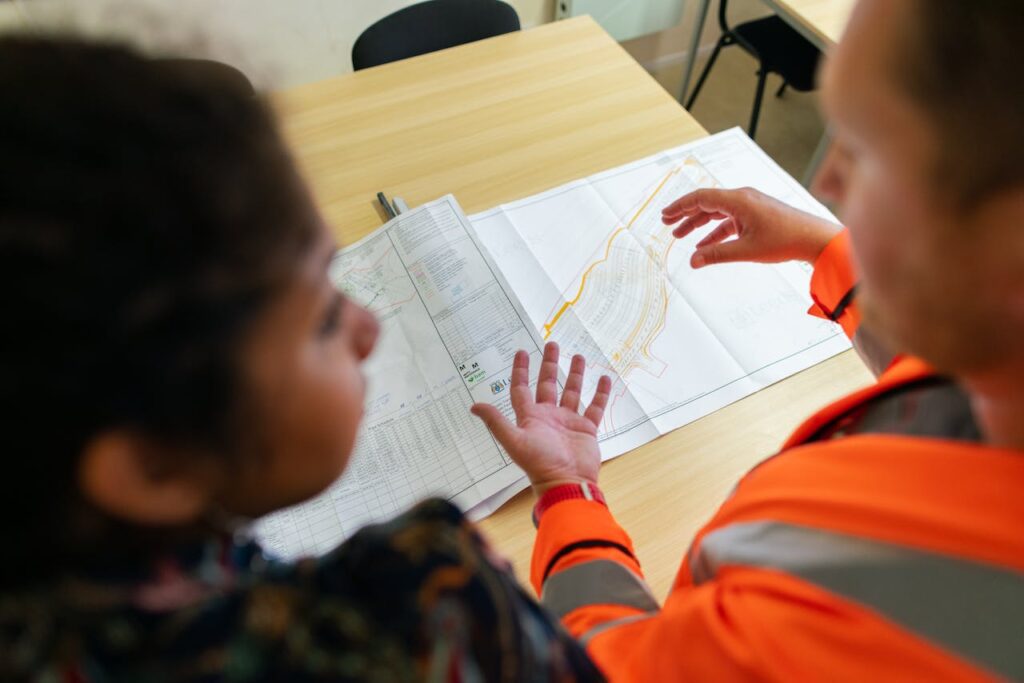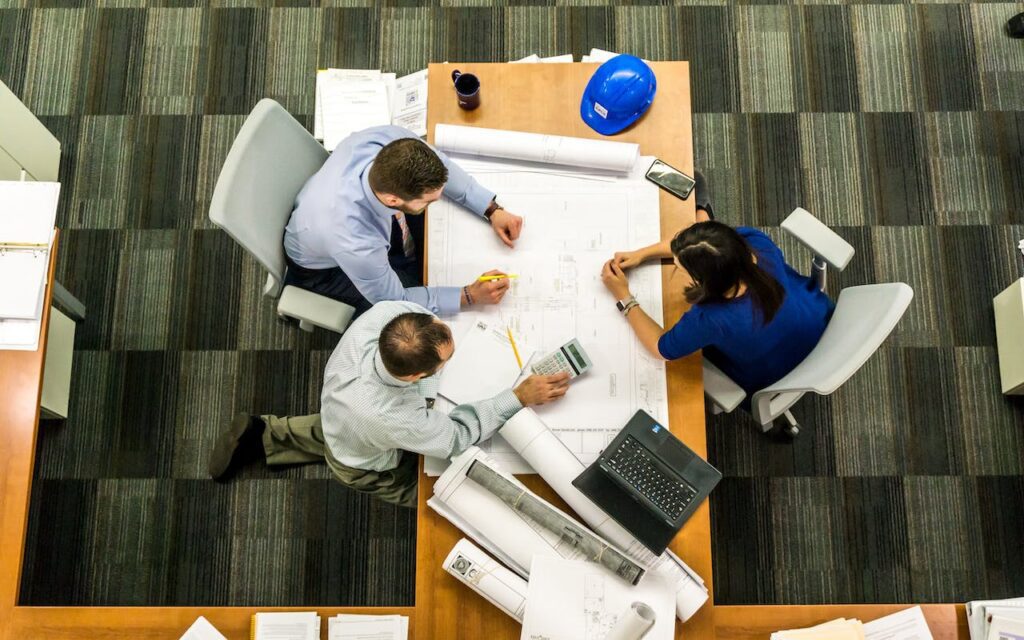Ever wondered how client communication impacts pre-construction planning? Building trust and transparency are crucial elements in this process. Effective communication sets the foundation for successful projects, ensuring all parties are aligned from the get-go. But how exactly does it work? Join us as we delve into the role of client communication in pre-construction planning, uncovering its significance in fostering strong relationships and driving project success. Ready to explore how clear and open dialogue can make or break a construction endeavor?
Importance Of Client Communication In Pre-Construction Planning
Ensuring Project Goals Understanding
Client communication plays a vital role in pre-construction planning by ensuring that project goals are clearly comprehended. This clarity helps align the expectations of both clients and construction professionals, reducing misunderstandings. When everyone involved understands the objectives, it becomes easier to work towards achieving them collectively.
Effective communication also involves active listening from both parties. By actively listening to clients’ needs and concerns, construction professionals can tailor their approach accordingly. This not only demonstrates attentiveness but also showcases a commitment to fulfilling the client’s requirements accurately.
Fostering Trust And Collaboration
Open lines of communication between clients and construction professionals foster trust and collaboration throughout the pre-construction phase. When there is transparency in discussions regarding timelines, budgets, or design preferences, trust is built naturally. Clients feel more confident when they are kept informed about every aspect of the project.
Moreover, continuous communication allows for immediate issue resolution during pre-construction planning stages. Clients appreciate being updated promptly on any challenges or changes as this demonstrates transparency and professionalism on part of the construction team.
- Clear understanding of project goals reduces misunderstandings.
- Active listening tailors approaches accurately.
- Transparency builds trust naturally.
- Immediate issue resolution showcases professionalism.
Impact Of Effective Communication On Trust And Transparency
Building Trust
Transparent communication is crucial in pre-construction planning to foster trust with clients. Regular updates and open dialogue are key components that contribute to building a strong foundation of trust. By keeping clients informed every step of the way, they feel involved and valued in the decision-making process.
Clients appreciate when they are kept in the loop about project developments, timelines, and any potential challenges. This level of transparency reassures them that their needs and concerns are being addressed promptly. For example, providing detailed progress reports or hosting regular meetings can significantly enhance trust between the construction team and the client.
Fostering Transparency
Open lines of communication lead to transparency throughout the pre-construction phase. Accountability is established when both parties engage in effective communication practices. Clients feel more confident in the construction process when they have access to information and can openly discuss any issues or changes.
When there is clarity in communication, misunderstandings are less likely to occur, minimizing conflicts down the line. For instance, clear explanations about budget allocations or design modifications help manage expectations effectively while maintaining a transparent approach to decision-making processes.
Pros:
- Enhanced client satisfaction
- Improved project outcomes
- Strengthened professional relationships
Cons:
- Time-consuming if not managed efficiently
- Potential for information overload if not streamlined
Incorporating feedback mechanisms such as surveys or feedback sessions can further demonstrate a commitment to transparency by actively seeking input from clients at various stages of pre-construction planning.
Strategies For Empowering Effective Communication
Clear Communication Protocols
Establishing clear communication protocols at the beginning of the pre-construction phase is crucial. This ensures that all parties involved understand how information will be shared, who to contact for specific inquiries, and what channels to use. By setting these guidelines early on, misunderstandings can be minimized, and everyone knows what is expected.
Effective communication protocols might include regular project update meetings, detailed reporting structures, and designated points of contact for different aspects of the project. This clarity helps prevent delays or errors due to miscommunication. For instance:
- Weekly progress meetings can keep stakeholders informed about developments.
- Using a centralized platform for sharing documents ensures that everyone has access to the most recent information.
Utilizing such protocols fosters a sense of organization and accountability among team members, promoting smoother workflows throughout the pre-construction planning process.
Open Dialogue And Active Listening
Encouraging open dialogue among stakeholders cultivates an environment where ideas can flow freely. When individuals feel comfortable expressing their thoughts and concerns, it enhances collaboration and problem-solving capabilities within the team. Active listening plays a significant role in this aspect as well; by truly hearing others’ perspectives without judgment or interruption, trust is built organically.
Incorporating feedback mechanisms like suggestion boxes or anonymous surveys allows every voice to be heard without fear of repercussions. Such practices promote inclusivity and show that each opinion matters in decision-making processes.
- Hosting brainstorming sessions where all participants are encouraged to contribute ideas promotes creativity.
- Conducting regular check-ins with team members provides opportunities for them to share any challenges they may be facing.
Utilizing Multiple Communication Channels For Client Satisfaction
Offer Various Channels
Ensuring client satisfaction in pre-construction planning involves offering various communication channels. By providing options like email, phone calls, and in-person meetings, clients can choose the method that suits them best. This flexibility fosters a sense of inclusivity and attentiveness.
Using multiple channels allows clients to engage comfortably based on their preferences. For instance, some clients might prefer the formality of emails for detailed discussions or updates, while others may find quick phone calls more convenient for urgent matters.
Adapt To Clients’ Preferences
Adapting to clients’ preferred methods is crucial in building trust and transparency during pre-construction planning. Understanding individual communication styles helps tailor interactions accordingly. Some clients might appreciate regular face-to-face meetings for personalized updates, while others may prefer concise emails outlining progress.
By aligning with how clients want to communicate, construction teams demonstrate a commitment to understanding their needs effectively. This personalized approach enhances client satisfaction by showing that their preferences are valued throughout the project lifecycle.
Use Project Management Software
Leveraging project management software streamlines communication processes and ensures everyone stays informed about project developments. These tools centralize information such as timelines, budgets, and milestones in one accessible platform. Clients benefit from real-time updates on progress without overwhelming email chains or scattered messages.
Project management software also promotes transparency by allowing all stakeholders to track changes collaboratively. For example, using platforms like Trello or Asana enables seamless sharing of documents and facilitates instant feedback loops between clients and construction teams.
Role Of Active Listening And Prompt Responses In Planning
Understanding Client Needs
Active listening is crucial in pre-construction planning as it allows construction professionals to grasp client needs effectively. By attentively listening to clients, construction teams can gain valuable insights into their preferences and expectations. For instance, when a client expresses a desire for eco-friendly materials, active listening ensures that this requirement is clearly understood.
Engaging in active listening also helps prevent misunderstandings or misinterpretations during the project. When clients feel heard and understood, it builds a foundation of trust between them and the construction team. This trust is essential for establishing strong relationships that are beneficial throughout the entire construction process.
Demonstrating Professionalism
Prompt responses play a significant role in showcasing professionalism during pre-construction planning. Responding promptly to client inquiries or messages conveys attentiveness and dedication towards meeting their needs efficiently. For example, if a client sends an email with questions about project timelines, providing a quick response demonstrates commitment to keeping them informed.
In addition to demonstrating attentiveness, prompt responses also contribute to maintaining transparency throughout the planning phase. Clients appreciate timely updates on progress or any changes that may arise during pre-construction activities. This level of communication fosters transparency and openness between both parties involved in the project.
Pros:
- Enhances understanding of client requirements.
- Builds trust through effective communication.
- Demonstrates professionalism and commitment.
Cons:
- Inadequate time management may lead to delayed responses.
Techniques For Clear Communication To Meet Client Expectations
Use Plain Language
Using plain language instead of technical jargon is crucial in pre-construction planning. By avoiding complex terms, you ensure that clients understand the project details easily. For instance, explaining “foundation” instead of using technical construction terminology ensures clarity.
When discussing architectural designs or construction methods, break down information into simple terms. This approach fosters better communication and helps prevent misunderstandings between you and your clients.
Pros:
- Enhances client understanding
- Minimizes confusion
Utilize Visual Aids
Incorporating visual aids like diagrams or 3D models can significantly enhance communication during pre-construction planning. These tools provide a clear visual representation of concepts that may be challenging to explain verbally. For example, showing a 3D model of the building layout can help clients visualize the final structure accurately.
Visual aids not only simplify complex ideas but also engage clients more effectively by offering them a tangible representation of the project’s scope and design.
Pros:
- Enhances comprehension
- Facilitates visualization
Summarize Key Points
Summarizing key points during discussions is essential to ensure alignment with client expectations in pre-construction planning. By summarizing critical details at various stages, you confirm that both parties are on the same page regarding project requirements and goals.
After each meeting or conversation, take a moment to recap key decisions made and next steps agreed upon with your clients. This practice reinforces transparency and accountability throughout the planning process.
Navigating Client Demands: Challenges And Solutions
Effective Negotiation Skills
Balancing client demands with project feasibility is crucial in pre-construction planning. It requires effective negotiation skills to ensure that both parties are satisfied. For instance, if a client requests an unrealistic timeline, it’s essential to discuss the challenges involved early on.
Negotiating effectively involves listening to the client’s needs while also considering what is realistically achievable within the project scope. By setting clear boundaries and expectations from the beginning, misunderstandings can be minimized.
Managing Expectations Collaboratively
One way to navigate client demands is by clearly communicating potential challenges or limitations at the outset of the project. This transparency helps manage client expectations and fosters trust throughout the construction process.
Collaboration with clients is key in finding mutually beneficial solutions when conflicts arise during pre-construction planning. For example, if a design change impacts the project timeline significantly, discussing alternative options together can lead to a solution that meets both parties’ needs.
Overcoming Communication Barriers For Improved Collaboration
Using Translators Or Interpreters
Language barriers can hinder effective communication between clients and construction teams. Translators or interpreters can bridge this gap by ensuring that information is accurately conveyed. For instance, if a client speaks Spanish and the construction team primarily speaks English, having a translator present in meetings ensures that everyone understands each other’s needs and expectations.
Cultural nuances play a significant role in communication effectiveness. Acknowledging and respecting cultural differences is crucial for building trust with clients from diverse backgrounds. By understanding cultural norms, values, and communication styles, construction professionals can tailor their approach to resonate better with clients. This fosters an environment of mutual respect and understanding.
Encouraging Open Dialogue
Open dialogue is key to addressing any communication barriers that may arise during pre-construction planning. Clients should feel comfortable expressing their concerns or asking questions about the project. Construction teams must create a welcoming atmosphere where clients feel heard and valued. By encouraging open communication channels, issues can be identified early on and resolved promptly.
Pros:
- Facilitates clear understanding between parties.
- Builds stronger relationships based on respect.
Cons:
- Requires additional resources such as hiring translators.
Best Practices For Communicating With Homeowners
Regular Updates
Keeping homeowners informed about project progress, timelines, and any changes is crucial. This transparency builds trust and ensures that everyone is on the same page throughout the pre-construction planning phase. By providing consistent updates, you establish a sense of reliability and accountability.
Consistent communication helps prevent misunderstandings and allows homeowners to feel involved in the process. For example, sending weekly emails or scheduling bi-weekly calls can keep them informed without overwhelming them with too much information at once.
Single Point Of Contact
Assigning a single point of contact for homeowners streamlines communication channels. Having one dedicated person to address their concerns or queries ensures efficiency and prevents confusion that may arise from multiple individuals providing conflicting information.
This approach also fosters a more personal connection between the homeowner and the construction team. It creates a direct line of communication where questions can be answered promptly, promoting trust and satisfaction throughout the project duration.
Involve Homeowners In Decision-Making
Actively involving homeowners in decision-making processes empowers them to have a say in their home’s construction. Seeking their input on design choices, materials selection, or other key decisions not only enhances the final outcome but also demonstrates respect for their preferences.
Summary
You’ve learned the crucial role of client communication in pre-construction planning. Effective communication builds trust, transparency, and satisfaction, ensuring successful project outcomes. By implementing strategies like active listening, utilizing various communication channels, and overcoming barriers, you can navigate client demands with ease. Remember, clear and prompt communication is key to meeting homeowner expectations and fostering strong relationships throughout the construction process. Embrace these best practices to enhance collaboration, mitigate challenges, and deliver exceptional results for both you and your clients.
Frequently Asked Questions
1. How Does Effective Client Communication Impact Trust And Transparency In Pre-Construction Planning?
Effective client communication builds trust by ensuring clear expectations are set and maintained throughout the project. Transparency is achieved through open, honest dialogue that keeps clients informed at every stage of the pre-construction process.
2. What Are Some Strategies For Empowering Effective Communication With Clients During Pre-Construction Planning?
Strategies include establishing regular check-ins, utilizing project management tools for updates, active listening to understand client needs, setting clear objectives from the start, and providing prompt responses to queries or concerns.
3. Why Is Active Listening Important In Client Communication During Pre-Construction Planning?
Active listening demonstrates empathy and understanding towards clients’ concerns and preferences. By actively engaging with clients’ feedback, construction teams can tailor their approach to meet specific needs effectively.
4. How Can Construction Professionals Overcome Common Communication Barriers When Working With Homeowners?
To overcome barriers like misunderstandings or differing expectations, it’s crucial to foster an environment of open dialogue. Encourage questions, provide clarification when needed, and address any issues promptly to ensure smooth collaboration with homeowners.
5. What Are Some Best Practices For Maintaining Effective Communication Channels With Homeowners Throughout A Construction Project?
Best practices include setting up regular progress meetings or updates via preferred channels (emails, calls), using visual aids like drawings or models for clarity, documenting decisions made during discussions accurately, and being proactive in addressing any potential issues before they escalate.
Optimize Your Project’s Success With Pre-Construction Planning By Red White & Blue Construction!
Embarking on a construction project in Lafayette, CA? Look no further than Red White & Blue Construction for expert pre-construction planning services! Specializing in laying the groundwork for successful construction projects, we tailor our pre-construction strategies to meet your specific project goals. Renowned for our expertise in pre-construction planning, we are committed to ensuring your project’s vision is meticulously planned and prepared for, whether it’s a residential, commercial, or community initiative. Our reputation across the Bay Area speaks to our dedication to precision, quality, and the exceptional standards we uphold in every phase of planning.
At Red White & Blue Construction, we do more than just prepare; we set the foundation for your project’s success. With our comprehensive planning, transparent pricing, and exceptional client service, you’re not just planning a construction project; you’re setting the stage for a seamless, efficient build. Choose Red White & Blue Construction for your pre-construction planning needs. Begin your project with confidence and contact us today!
Disclaimer
The materials available on this website are for informational and entertainment purposes only and not to provide advice. You should obtain advice concerning any particular issue or problem from a professional. You should not act or refrain from acting based on any content included in this site without seeking legal or other professional advice. The information presented on this website may not reflect the most current building developments. No action should be taken in reliance on the information on this website. We disclaim all liability concerning actions taken or not taken based on any or all of the contents of this site to the fullest extent permitted by law.





